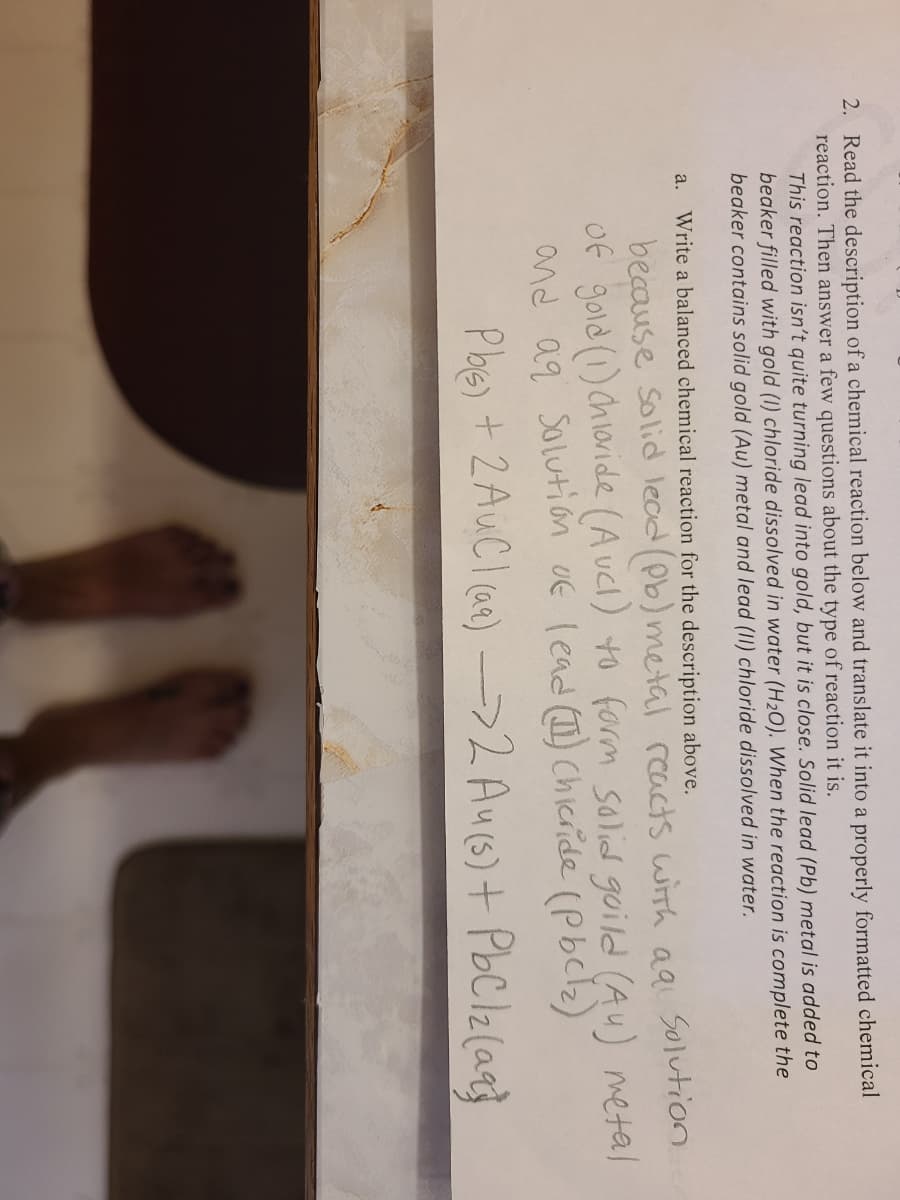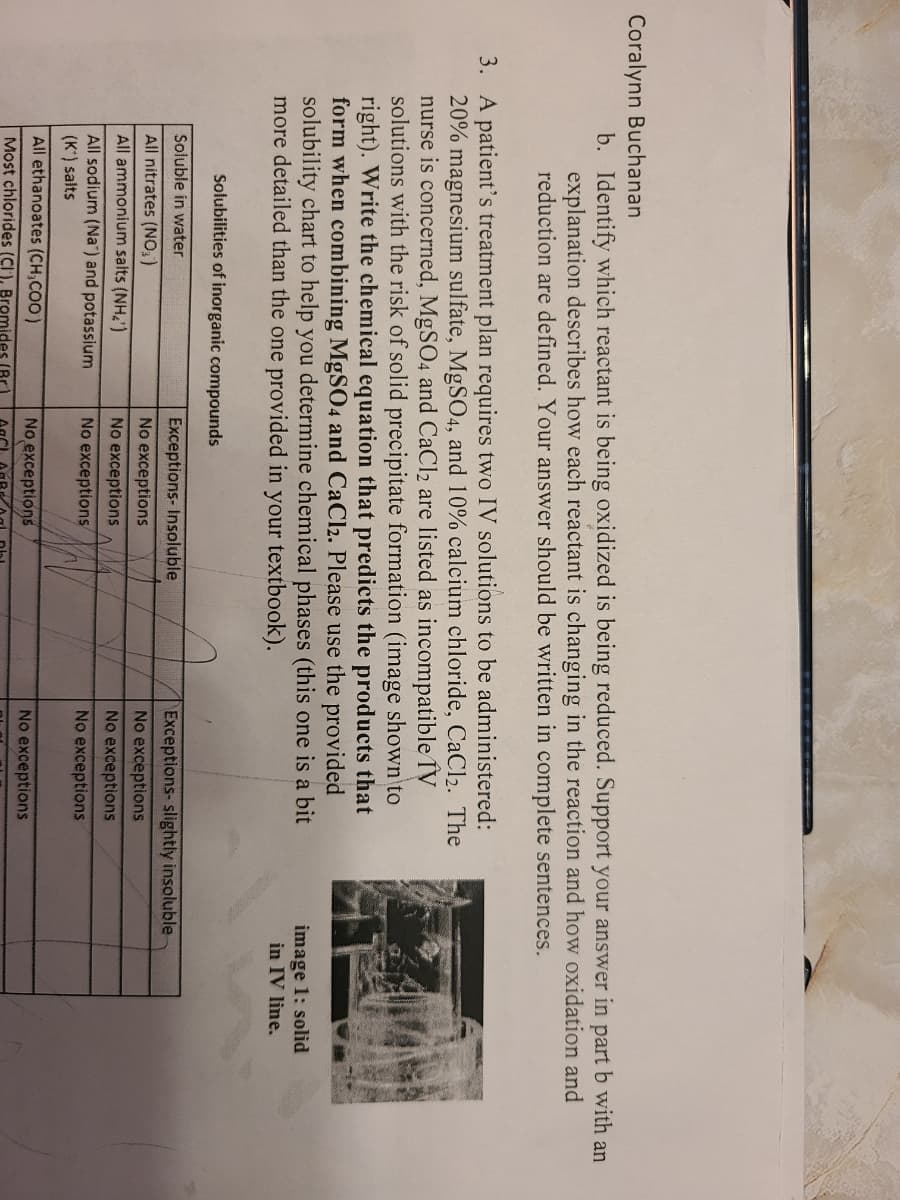Coralynn Buchanan b. Identify which reactant is being oxidized is being reduced. Support your answer in part b u explanation describes how each reactant is changing in the reaction and how oxidation anc reduction are defined. Your answer should be written in complete sentences. 3. A patient's treatment plan requires two IV solutions to be administered: 20% magnesium sulfate, MgS04, and 10% calcium chloride, CaCl2. The nurse is concerned, MgSO4 and CaCl2 are listed as incompatible IV solutions with the risk of solid precipitate formation (image shown to right). Write the chemical equation that predicts the products that form when combining MgSO4 and CaCl2. Please use the provided solubility chart to help you determine chemical phases (this one is a bit more detailed than the one provided in your textbook). image 1: solid in IV line.
Coralynn Buchanan b. Identify which reactant is being oxidized is being reduced. Support your answer in part b u explanation describes how each reactant is changing in the reaction and how oxidation anc reduction are defined. Your answer should be written in complete sentences. 3. A patient's treatment plan requires two IV solutions to be administered: 20% magnesium sulfate, MgS04, and 10% calcium chloride, CaCl2. The nurse is concerned, MgSO4 and CaCl2 are listed as incompatible IV solutions with the risk of solid precipitate formation (image shown to right). Write the chemical equation that predicts the products that form when combining MgSO4 and CaCl2. Please use the provided solubility chart to help you determine chemical phases (this one is a bit more detailed than the one provided in your textbook). image 1: solid in IV line.
Living By Chemistry: First Edition Textbook
1st Edition
ISBN:9781559539418
Author:Angelica Stacy
Publisher:Angelica Stacy
ChapterU4: Toxins: Stoichiometry, Solution Chemistry, And Acids And Bases
Section: Chapter Questions
Problem SI3RE
Related questions
Question
100%
Using the question from number 2 in the first picture, answer part b in the second picture.

Transcribed Image Text:2. Read the description of a chemical reaction below and translate it into a properly formatted chemical
reaction. Then answer a few questions about the type of reaction it is.
This reaction isn't quite turning lead into gold, but it is close. Solid lead (Pb) metal is added to
beaker filled with gold (1) chloride dissolved in water (H2O). When the reaction is complete the
beaker contains solid gold (Au) metal and lead (II) chloride dissolved in water.
a. Write a balanced chemical reaction for the description above.
because Solid lead (Pb)metal rcacts wiTTh ag Solution
of gold (1) chioride (A ucl) to form Ssolied goild (Au) metal
and aq solution UE lead Chicride (Pbclz)
Pbe) + 2AUCI ae) 2 Auc) + PbClz(az}

Transcribed Image Text:Coralynn Buchanan
b. Identify which reactant is being oxidized is being reduced. Support your answer in part b with an
explanation describes how each reactant is changing in the reaction and how oxidation and
reduction are defined. Your answer should be written in complete sentences.
3. A patient's treatment plan requires two IV solutions to be administered:
20% magnesium sulfate, MgS04, and 10% calcium chloride, CaCl2. The
nurse is concerned, MgSO4 and CaCl2 are listed as incompatible IV
solutions with the risk of solid precipitate formation (image shown to
right). Write the chemical equation that predicts the products that
form when combining MgSO4 and CaCl2. Please use the provided
solubility chart to help you determine chemical phases (this one is a bit
more detailed than the one provided in your textbook).
image 1: solid
in IV line.
Solubilities of inorganic compounds
Soluble in water
Exceptions- Insoluble
Exceptions- slightly insoluble
All nitrates (NO, )
No exceptions
No exceptions
All ammonium salts (NH2')
No exceptions
No exceptions
All sodium (Na") and potassium
(K) salts
No exceptions
No exceptions
All ethanoates (CH,COO)
No exceptions
No exceptions
Most chlorides (CI ), Bromides (Br
Expert Solution
This question has been solved!
Explore an expertly crafted, step-by-step solution for a thorough understanding of key concepts.
This is a popular solution!
Trending now
This is a popular solution!
Step by step
Solved in 2 steps with 1 images

Knowledge Booster
Learn more about
Need a deep-dive on the concept behind this application? Look no further. Learn more about this topic, chemistry and related others by exploring similar questions and additional content below.Recommended textbooks for you

Living By Chemistry: First Edition Textbook
Chemistry
ISBN:
9781559539418
Author:
Angelica Stacy
Publisher:
MAC HIGHER

Introductory Chemistry: A Foundation
Chemistry
ISBN:
9781337399425
Author:
Steven S. Zumdahl, Donald J. DeCoste
Publisher:
Cengage Learning

World of Chemistry, 3rd edition
Chemistry
ISBN:
9781133109655
Author:
Steven S. Zumdahl, Susan L. Zumdahl, Donald J. DeCoste
Publisher:
Brooks / Cole / Cengage Learning

Living By Chemistry: First Edition Textbook
Chemistry
ISBN:
9781559539418
Author:
Angelica Stacy
Publisher:
MAC HIGHER

Introductory Chemistry: A Foundation
Chemistry
ISBN:
9781337399425
Author:
Steven S. Zumdahl, Donald J. DeCoste
Publisher:
Cengage Learning

World of Chemistry, 3rd edition
Chemistry
ISBN:
9781133109655
Author:
Steven S. Zumdahl, Susan L. Zumdahl, Donald J. DeCoste
Publisher:
Brooks / Cole / Cengage Learning

Chemistry: The Molecular Science
Chemistry
ISBN:
9781285199047
Author:
John W. Moore, Conrad L. Stanitski
Publisher:
Cengage Learning

Chemistry: An Atoms First Approach
Chemistry
ISBN:
9781305079243
Author:
Steven S. Zumdahl, Susan A. Zumdahl
Publisher:
Cengage Learning

Chemistry
Chemistry
ISBN:
9781305957404
Author:
Steven S. Zumdahl, Susan A. Zumdahl, Donald J. DeCoste
Publisher:
Cengage Learning